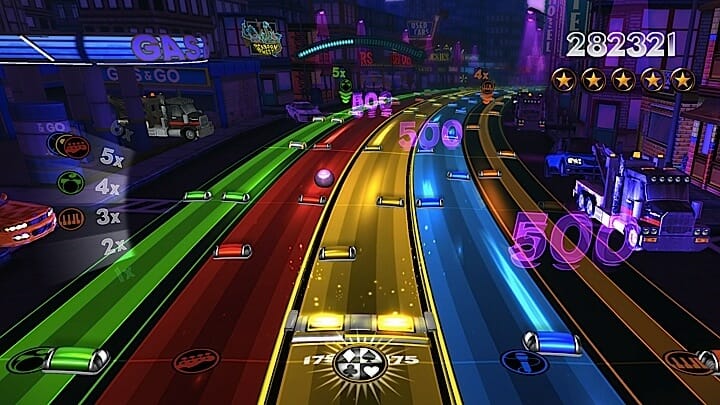Rock Band Blitz (Multi-Platform)

I’ve gotten busier and more inflexible since Rock Band took the world by storm. I’m older and my priorities have shifted. I remember a time when I was fine leaving plastic instruments in my living room, when my friends and I weren’t too self-conscious to rock out fully in one another’s presence, when my neighbors were apathetic about loud noises coming from my apartment; they made a similar racket themselves at times. Me, my friends, my neighbors, we all had an agreement: we would let ourselves go once in a while.
Now, I live on the third floor of an apartment full of old people, many of whom are cranky about loud noises, especially after 10 pm. Once I got an official “notice of lease violation” from the apartment office for being too loud. It read:
“I have received several complaints concerning: 1) Loud television; possibly playing video games or a Wii late at night 11:30 pm to 12:00 am. This is an apartment building, not a single family dwelling. You must be considerate of your neighbors.”
That served as my official “you are never going to play Rock Band in your house again” notice. If they couldn’t handle Mortal Kombat turned up loud enough to hear late at night, they certainly wouldn’t abide by my wailing impersonation of Rivers Cuomo or the clacking of plastic drums. This was the end of an era.
So I welcomed the possibility of a Rock Band I could play alone in my apartment with my wireless gaming headset in place. Perhaps besides its use of a standard game controller and its solitary play-style, it would still give me the sense of truly investing myself in the music. Maybe I could finally rock out again.
Well, not really. Playing Rock Band Blitz makes me feel less like a rock star and more like an engineer, analyzing patterns and flipping switches. I’m tasked with moving between four or five lanes, each lane representing a different instrument, and juggling each part in order to maximize my score. Hammering on the left and right trigger moves from drums to bass to guitar to vocals to keyboards; along the way, tapping either the a button or the d-pad activates one of two notes in each lane. All of these mechanics hover in the foreground of the screen and the player’s mind.

Meanwhile, songs play in the background, certainly a key aspect of the game, but far from the primary concern of the player. The player switches and juggles, but rarely plays in the musical sense. The game has challenges, but they are challenging in the impulsive sense, a test of reflexes rather than musical propensity. The music is meant to seem to play a major role. Whichever instrument’s track is currently being played is amplified. The role of each instrument is adequately clarified. The player does come away from the game with some sense of the musicality of the track.
-

-

-

-

-

-

-

-

-

-

-

-

-

-

-

-

-

-

-

-

-

-

-

-

-

-

-

-

-

-

-

-

-

-

-

-

-

-

-

-








































